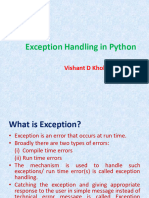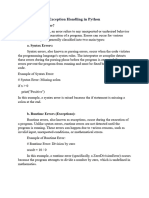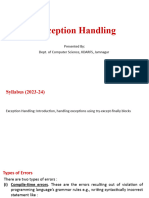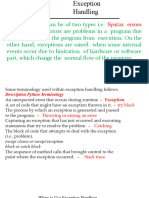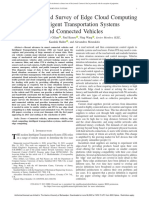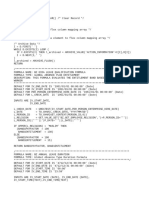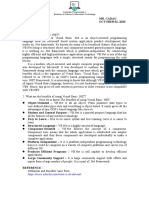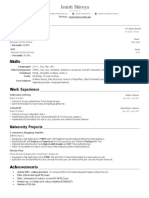8.exception Notes
Uploaded by
vishaks27228.exception Notes
Uploaded by
vishaks2722Exception Handling :
try:
# Code that may raise an exception
except ExceptionType:
# Code to handle the exception
else:
# Code to execute if no exception occurs
finally:
# Code that always runs, regardless of an exception
Exception Handling in Python
Exception handling in Python is a way to handle errors and other exceptional
conditions in your code in a graceful manner. When something goes wrong in a
Exception Handling : 1
program, an exception is raised. If not handled properly, the program crashes.
However, Python provides a structured way to catch and handle these exceptions
to ensure that the program can either recover or at least fail gracefully.
Key Concepts of Exception Handling
1. Exceptions: An exception is an event that occurs during the execution of a
program that disrupts its normal flow. Examples of exceptions include division
by zero, file not found, or invalid input.
2. Raising Exceptions: You can raise exceptions in your code using the raise
keyword. This is useful when you want to explicitly trigger an error based on
certain conditions.
3. Handling Exceptions: You can handle exceptions using the try , except , else ,
and finally blocks.
4. Custom Exceptions: You can define your own exceptions by creating custom
exception classes.
Raising Exceptions
You can raise exceptions manually in your code using the raise keyword followed
by the exception you want to raise.
Example:
pythonCopy code
def check_age(age):
if age < 18:
raise ValueError("Age must be 18 or older.")
return "Age is valid."
try:
print(check_age(16))
except ValueError as e:
print(f"Error: {e}")
Exception Handling : 2
Exception Hierarchy
All exceptions in Python are derived from the base class BaseException . Some
common exceptions include:
Exception: The base class for most exceptions.
ArithmeticError: The base class for arithmetic errors like ZeroDivisionError .
ValueError: Raised when a function gets an argument of the correct type but
with an invalid value.
TypeError: Raised when an operation or function is applied to an object of
inappropriate type.
IOError: Raised when an input/output operation fails.
KeyError: Raised when a dictionary key is not found.
Basic Syntax of Exception Handling
Python uses the try , except , else , and finally blocks to handle exceptions.
Syntax:
pythonCopy code
try:
# Code that may raise an exception
except ExceptionType as e:
# Code that runs if the exception occurs
else:
# Code that runs if no exception occurs
finally:
# Code that runs no matter what (optional)
try : Contains code that might throw an exception.
except : Contains code that runs when an exception is raised in the try block.
else : Contains code that runs if no exception is raised in the try block.
Exception Handling : 3
finally: Contains code that always runs, whether an exception was raised or
not (e.g., closing files).
Example: Handling Exceptions
pythonCopy code
try:
num1 = int(input("Enter a number: "))
num2 = int(input("Enter another number: "))
result = num1 / num2
except ZeroDivisionError:
print("Error: Division by zero is not allowed.")
except ValueError:
print("Error: Invalid input. Please enter a valid numbe
r.")
else:
print(f"The result is: {result}")
finally:
print("This block is always executed, whether an exceptio
n occurred or not.")
Multiple Exceptions
You can catch multiple exceptions by specifying them in a tuple.
pythonCopy code
try:
num = int(input("Enter a number: "))
result = 100 / num
except (ValueError, ZeroDivisionError) as e:
print(f"Error: {e}")
The finally Block
Exception Handling : 4
The finally block is used for cleaning up resources, such as closing files or
releasing locks, regardless of whether an exception occurred.
pythonCopy code
try:
f = open('somefile.txt', 'r')
# Some file operations
except FileNotFoundError:
print("File not found.")
finally:
f.close() # Ensures that the file is closed no matter wh
at
Creating Custom Exceptions
You can create your own exceptions by defining a class that inherits from
Exception .
Example:
pythonCopy code
class CustomError(Exception):
pass
def check_positive(number):
if number < 0:
raise CustomError("Number must be positive.")
try:
check_positive(-5)
except CustomError as e:
print(f"Custom Error: {e}")
Exception Handling : 5
tryexceptelse
The else block runs only if no exceptions were raised in the try block.
pythonCopy code
try:
result = 10 / 2
except ZeroDivisionError:
print("Cannot divide by zero.")
else:
print("Division successful.")
Common Built-in Exceptions
Here are some commonly encountered built-in exceptions in Python:
AttributeError : Raised when an invalid attribute reference is made.
IndexError : Raised when a sequence index is out of range.
KeyError : Raised when a dictionary key is not found.
TypeError : Raised when an operation is applied to an object of inappropriate
type.
ValueError : Raised when a function receives an argument of the correct type
but inappropriate value.
FileNotFoundError : Raised when a file or directory is requested but doesn't exist.
IOError : Raised when an I/O operation fails.
Nested Exception Handling
You can nest try-except blocks within each other. This is useful when multiple
layers of error handling are needed.
Example:
pythonCopy code
try:
Exception Handling : 6
try:
num = int(input("Enter a number: "))
result = 10 / num
except ValueError:
print("Invalid input.")
except ZeroDivisionError:
print("Cannot divide by zero.")
Best Practices for Exception Handling
1. Catch Specific Exceptions: Always catch the most specific exceptions
possible, instead of catching everything with a bare except .
2. Use Finally for Cleanup: Use the finally block to clean up resources, such as
closing files or releasing locks.
3. Avoid Overuse of Exceptions: Don't use exceptions for normal control flow;
reserve them for exceptional cases.
4. Log Exceptions: Log exceptions to help with debugging instead of just printing
them.
Example: Logging Exceptions
pythonCopy code
import logging
try:
num = int(input("Enter a number: "))
result = 100 / num
except ZeroDivisionError as e:
logging.error("Attempted division by zero")
except ValueError as e:
logging.error("Invalid input provided")
Exception Handling : 7
Here is a summary table of common Python errors and their descriptions:
Error Type Description Example Cause
Raised when there is invalid syntax Missing colon in an if
SyntaxError
in the code. statement.
Raised when there is incorrect Extra or missing indentation
IndentationError
indentation. in a block of code.
Raised when a variable or function Using a variable that hasn't
NameError
name is not defined. been initialized.
Raised when an operation is
TypeError Adding a string to an integer.
performed on an inappropriate type.
Raised when a function receives an
Converting a non-numeric
ValueError argument of correct type but
string to an integer.
inappropriate value.
Raised when accessing an index out Accessing the 5th element
IndexError
of range in a sequence. of a list with only 3 items.
Raised when a dictionary key is not Accessing a non-existent
KeyError
found. key in a dictionary.
Raised when an invalid attribute Accessing an undefined
AttributeError
reference is made. attribute of an object.
Raised when attempting to divide by
ZeroDivisionError Dividing a number by zero.
zero.
Raised when an import statement Importing a non-existent
ImportError
fails to find the module. module.
A subclass of ImportError , raised Importing a module that
ModuleNotFoundError
when a module cannot be found. doesn't exist.
Raised when a file operation fails Trying to open a non-
FileNotFoundError
due to the file not existing. existent file.
Attempting to read from a
IOError Raised when an I/O operation fails.
file that is closed.
Exception Handling : 8
Raised when the result of an Calculating an extremely
OverflowError
arithmetic operation is too large. large exponential.
Raised when an operation runs out Creating a very large list that
MemoryError
of memory. exceeds memory.
Raised when there are no further Using next() on an iterator
StopIteration
items in an iterator. beyond its limit.
Raised when an assert statement
AssertionError Failing an assertion check.
fails.
Raised when an error occurs that
Exceeding the recursion
RuntimeError does not belong to any specific
depth.
category.
NotImplementedError
Raised when an abstract method is Calling an unimplemented
called in a base class. method in a subclass.
Pressing Ctrl+D (Unix) or
Raised when input() reaches the
EOFError Ctrl+Z (Windows) during
end of the file unexpectedly.
input.
Raised when the user interrupts Stopping a running program
KeyboardInterrupt
program execution with Ctrl+C . with Ctrl+C .
1. SyntaxError
Description: Raised when the code contains invalid syntax.
Example 1: Missing colon in an if statement.
if True
print("This will raise a SyntaxError")
Example 2: Using an assignment operator ( = ) instead of an equality operator
( == ) in a conditional statement.
Exception Handling : 9
pythonCopy code
if x = 5: # Should be 'if x == 5:'
print("This will raise a SyntaxError")
2. IndentationError
Description: Raised when the code is not properly indented.
Example 1: Missing indentation in a block of code.
def my_function():
print("This will raise an IndentationError") # This line
should be indented
Example 2:
for i in range(5):
print(i) # Should be indented inside the loop
3. NameError
Description: Raised when a variable or function name is not defined.
Example 1: Using a variable that hasn't been initialized.
print(x) # x is not defined, this will raise a NameError
Example 2: Calling a function that has not been declared.
Exception Handling : 10
my_function() # This will raise a NameError if 'my_functi
on' is not defined
4. TypeError
Description: Raised when an operation is applied to an object of inappropriate
type.
Example 1: Adding a string and an integer.
result = "Hello" + 5 # This will raise a TypeError
Example 2: Passing the wrong type of argument to a function.
def add_numbers(a, b):
return a + b
add_numbers(5, "10") # This will raise a TypeError
5. ValueError
Description: Raised when a function receives an argument of the correct type
but inappropriate value.
Example 1: Converting a non-numeric string to an integer.
number = int("abc") # This will raise a ValueError
Example 2: Providing an out-of-range value for a specific function.
Exception Handling : 11
import math
result = math.sqrt(-1) # This will raise a ValueError
6. IndexError
Description: Raised when trying to access an index that is out of range in a
sequence (like a list or tuple).
Example 1: Accessing an out-of-range index in a list.
my_list = [1, 2, 3]
print(my_list[5]) # This will raise an IndexError
Example 2: Accessing an invalid index in a tuple.
my_tuple = (10, 20, 30)
print(my_tuple[4]) # This will raise an IndexError
7. KeyError
Description: Raised when trying to access a key that does not exist in a
dictionary.
Example 1: Accessing a non-existent key in a dictionary.
my_dict = {'a': 1, 'b': 2}
print(my_dict['c']) # This will raise a KeyError
Exception Handling : 12
Example 2: Attempting to retrieve a key that isn't present in a dictionary.
my_dict = {'name': 'John'}
print(my_dict['age']) # This will raise a KeyError
8. AttributeError
Description: .
Example 1: Accessing a non-existent method of a string.
my_string = "Hello"
my_string.append(" World") # This will raise an Attribute
Error
Example 2: Trying to access an undefined attribute of an object.
class MyClass:
pass
obj = MyClass()
print(obj.attribute) # This will raise an AttributeError
9. ZeroDivisionError
Description: Raised when attempting to divide by zero.
Example 1: Dividing an integer by zero.
result = 10 / 0 # This will raise a ZeroDivisionError
Exception Handling : 13
Example 2: Performing integer division by zero.
pythonCopy code
result = 10 // 0 # This will raise a ZeroDivisionError
10. ImportError / ModuleNotFoundError
Description: Raised when an import statement fails to find a module.
Example 1: Importing a module that doesn’t exist.
import non_existent_module # This will raise a ModuleNotF
oundError
Example 2: Importing a non-existent function from a valid module.
pythonCopy code
from math import nonexistent_function # This will raise a
n ImportError
11. FileNotFoundError
Description: Raised when a file operation fails due to the file not existing.
Example 1: Trying to open a non-existent file.
file = open("non_existent_file.txt") # This will raise a
FileNotFoundError
Exception Handling : 14
Example 2: Reading a file that has been deleted.
import os
os.remove("myfile.txt")
file = open("myfile.txt") # This will raise a FileNotFoun
dError
12. IOError
Description: Raised when an I/O operation fails (e.g., file read/write).
Example 1: Trying to read a closed file.
pythonCopy code
file = open("file.txt", "r")
file.close()
file.read() # This will raise an IOError
Example 2: Trying to write to a read-only file.
pythonCopy code
file = open("file.txt", "r")
file.write("Hello") # This will raise an IOError
Type Errors:
Exception Handling : 15
1. Unsupported Operation Between Two Types
In this case, you are trying to use an operation (like + ) between incompatible
types, such as trying to add a string and an integer.
Example:
pythonCopy code
name = "John"
age = 25
print(name + age) # Trying to add a string and an integer.
Output:
pythonCopy code
TypeError: can only concatenate str (not "int") to str
Solution: Convert the integer to a string before adding:
pythonCopy code
print(name + str(age))
2. Calling a Non-Callable Object
This error occurs when you mistakenly try to call a variable or object as if it were a
function, but it's not.
Example:
pythonCopy code
name = "John"
print(name()) # Trying to call a string like a function.
Output:
Exception Handling : 16
pythonCopy code
TypeError: 'str' object is not callable
Solution: Remove the parentheses () if you are not trying to call a function.
pythonCopy code
print(name)
3. Incorrect List Index Type
In Python, list indices must be integers. If you try to access a list using a non-
integer value, it will raise a TypeError .
Example:
pythonCopy code
fruits = ["apple", "banana", "cherry"]
index = "1"
print(fruits[index]) # Using a string as a list index.
Output:
pythonCopy code
TypeError: list indices must be integers or slices, not str
Solution: Convert the string index to an integer before using it.
pythonCopy code
print(fruits[int(index)])
Exception Handling : 17
4. Iterating Over a Non-Iterable Object
This happens when you try to loop through an object that can’t be iterated over
(e.g., trying to loop through a number).
Example:
pythonCopy code
number = 12345
for digit in number: # Trying to iterate over an integer.
print(digit)
Output:
pythonCopy code
TypeError: 'int' object is not iterable
Solution: Convert the number to a string (or list) if you want to iterate through its
digits.
pythonCopy code
for digit in str(number):
print(digit)
5. Passing an Argument of the Wrong Type to a Function
When a function expects arguments of a specific type, passing the wrong type
can raise a TypeError .
Example:
pythonCopy code
def subtract_numbers(a, b):
return a - b
Exception Handling : 18
result = subtract_numbers("5", 3) # Passing a string instead
of a number.
Output:
pythonCopy code
TypeError: unsupported operand type(s) for -: 'str' and 'int'
Solution: Ensure that the arguments passed to the function are of the correct
type.
pythonCopy code
result = subtract_numbers(int("5"), 3)
Value Error :
What is a ValueError in Python?
A ValueError occurs when a function receives an argument of the correct data
type but an inappropriate or invalid value. It can also happen during unpacking of
iterable objects when there is a mismatch in the number of elements.
Common Reasons for ValueError
1. Invalid Argument
ValueError commonly occurs when you pass an invalid argument to a function. For
example, the float() function can convert a number to a float, but if you pass a
string that cannot be converted, Python raises a ValueError .
Example:
Exception Handling : 19
pythonCopy code
x = 25
y = "abc" # This is an invalid argument for float()
print(float(x)) # Works fine
print(float(y)) # Raises ValueError
Output:
pythonCopy code
25.0
ValueError: could not convert string to float: 'abc'
Solution: Make sure to pass valid arguments to functions.
pythonCopy code
try:
print(float(x))
print(float(y))
except ValueError:
print("Error: Cannot convert the string to a float.")
2. Incorrect Use of Math Module
Sometimes, ValueError is raised when you pass an invalid value to a function in the
math module. For instance, the math.factorial() function only accepts non-
negative integers. Passing a negative number will cause a ValueError .
Example:
pythonCopy code
import math
Exception Handling : 20
print(math.factorial(-5)) # Raises ValueError because the in
put is negative
Output:
pythonCopy code
ValueError: factorial() not defined for negative values
Solution: Validate your input before calling the function.
pythonCopy code
import math
n = 3
if n >= 0:
print(math.factorial(n))
else:
print("Error: Factorial is not defined for negative numbe
rs.")
3. Unpacking an Iterable Object
When unpacking iterable objects like lists, tuples, or sets, if the number of
variables doesn’t match the number of elements in the iterable, a ValueError will be
raised.
Example:
pythonCopy code
my_list = [1, 2, 3]
a, b, c, d = my_list # Trying to unpack 4 values from a list
with only 3 elements
Exception Handling : 21
Output:
pythonCopy code
ValueError: not enough values to unpack (expected 4, got 3)
Solution: Ensure the number of variables matches the number of items in the
iterable.
pythonCopy code
my_list = [1, 2, 3]
a, b, c = my_list # Correct number of variables
print(a, b, c)
index Error:
What Causes an IndexError in Python?
An IndexError in Python is raised when you attempt to access an index in a
sequence (like a list or string) that does not exist. Here are common scenarios that
cause this error:
1. Accessing a Non-Existent Index: This occurs when you try to access an index
that is beyond the valid range of indices for a sequence. Python sequences
are zero-indexed, meaning the first element has an index of 0, the second has
an index of 1, and so on.
Example:
my_list = [1, 2, 4]
print(my_list[4]) # This will raise an IndexError because
Exception Handling : 22
index 4 is out of range.
Output:
2. Empty List: Attempting to access any index in an empty list will raise an
IndexError because there are no elements in the list.
Example:
empty_list = []
print(empty_list[0]) # This will raise an IndexError beca
use the list is empty.
Output:
3.
0.
Example:
my_string = "Example"
print(my_string[-10]) # This will raise an IndexError bec
ause -10 is out of range for this string.
Output:
Modifying a List While Iterating Over It
Situation: If you modify a list (e.g., by deleting elements) while iterating over it,
you might inadvertently cause an IndexError .
Example:
Exception Handling : 23
pythonCopy code
my_list = [1, 2, 3, 4]
for i in range(len(my_list)):
print(my_list[i])
my_list.pop() # Reduces the list size
# IndexError: list index out of range
Key Errors :
Example 1: Accessing a Non-Existent Key in a Dictionary
This is the most common scenario where a KeyError occurs.
pythonCopy code
my_dict = {'name': 'Alice', 'age': 25}
# Trying to access a key that does not exist
print(my_dict['gender']) # KeyError: 'gender'
Explanation: The dictionary my_dict does not have the key 'gender' , so trying
to access it results in a KeyError .
Example 2: Using .pop() on a Non-Existent Key
The pop() method can also raise a KeyError if the specified key is not present in
the dictionary.
pythonCopy code
my_dict = {'name': 'Alice', 'age': 25}
Exception Handling : 24
# Trying to pop a key that does not exist
my_dict.pop('gender') # KeyError: 'gender'
Explanation: The key 'gender' does not exist in the dictionary, so calling pop()
with this key causes a KeyError .
Example 3: Using .get() or in to Avoid KeyError (Safe Access)
A KeyError can be avoided using the .get() method, which returns None or a
default value if the key is not found, or by checking if the key exists first.
pythonCopy code
my_dict = {'name': 'Alice', 'age': 25}
# Safe access using .get()
gender = my_dict.get('gender', 'Not specified')
print(gender) # Output: Not specified
# Safe access using 'in'
if 'gender' in my_dict:
print(my_dict['gender'])
4o
Attribute Error :
Understanding AttributeError in Python
An AttributeError in Python is raised when an invalid attribute reference is made.
This error typically occurs when trying to access or call an attribute or method
that does not exist for a given object.
Exception Handling : 25
Here are some common causes of AttributeError with examples:
1. Accessing a Non-Existent Attribute or Method
When you try to call a method or access an attribute that doesn’t exist for the data
type or object, an AttributeError will be raised.
Example 1:
# Python program to demonstrate AttributeError
X = 10
# Raises an AttributeError because integers do not have an 'a
ppend' method
X.append(6)
Output:
plaintextCopy code
Traceback (most recent call last):
File "/path/to/your/script.py", line 5, in <module>
X.append(6)
AttributeError: 'int' object has no attribute 'append'
2. Incorrect Method Name Due to Typographical Error
Python is case-sensitive, so a typo or incorrect case in method names will lead to
an AttributeError .
Example 2:
# Python program to demonstrate AttributeError
Exception Handling : 26
# Raises an AttributeError as there is no method 'fst' for st
rings
string = "The famous website is { }".fst("geeksforgeeks")
print(string)
Output:
plaintextCopy code
Traceback (most recent call last):
File "/path/to/your/script.py", line 3, in <module>
string = "The famous website is { }".fst("geeksforgeeks")
AttributeError: 'str' object has no attribute 'fst'
3. Accessing a Non-Existent Attribute in a User-Defined Class
An AttributeError can occur in user-defined classes if you attempt to access an
attribute that hasn’t been defined.
Example 3:
# Python program to demonstrate AttributeError
class Geeks:
def __init__(self):
self.a = 'GeeksforGeeks'
# Driver's code
obj = Geeks()
print(obj.a)
# Raises an AttributeError because 'b' is not defined in the
Geeks class
Exception Handling : 27
print(obj.b)
Output:
plaintextCopy code
GeeksforGeeks
Traceback (most recent call last):
File "/path/to/your/script.py", line 17, in <module>
print(obj.b)
AttributeError: 'Geeks' object has no attribute 'b'
How to Fix AttributeError
Here are some approaches to handle and prevent AttributeError :
1. Verify Attribute Names: Ensure that the attribute or method names are correct
and exist for the object you are working with.
2. Check Object Type: Confirm that the object is of the type you expect and that
it supports the attribute or method you are trying to access.
3. Debug and Fix Typographical Errors: Ensure that method names and attribute
references are spelled correctly and use the correct case.
4. Verify Indentation: Check that methods and attributes are correctly defined
with proper indentation in classes.
Name Error :
Understanding NameError in Python
Exception Handling : 28
A NameError in Python is raised when an identifier (such as a variable or function) is
not defined in the local or global scope. Here are some common causes of
NameError and how to address them:
1. Misspelled Built-in Functions
A NameError can occur if you mistakenly misspell a built-in function or keyword.
Python will not recognize the misspelled name and will raise a NameError .
Example 1:
pythonCopy code
geek = input()
prnt(geek) # Misspelled 'print' as 'prnt'
Output:
plaintextCopy code
NameError: name 'prnt' is not defined
Fix: Ensure that built-in functions and keywords are spelled correctly.
pythonCopy code
geek = input()
print(geek) # Correct spelling
2. Using Undefined Variables
A NameError will be raised if you attempt to use a variable that has not been
defined.
Example 2:
pythonCopy code
geeky = input()
Exception Handling : 29
print(geek) # 'geek' is not defined
Output:
plaintextCopy code
NameError: name 'geek' is not defined
Fix: Make sure that variables are defined before they are used.
pythonCopy code
geek = input()
print(geek) # Correct variable name
3. Defining Variable After Usage
In Python, code is executed from top to bottom. If you use a variable before it is
defined, Python will raise a NameError .
Example 3:
pythonCopy code
print(geek) # 'geek' is used before it is defined
geek = "GeeksforGeeks"
Output:
plaintextCopy code
NameError: name 'geek' is not defined
Fix: Define variables before you use them.
Exception Handling : 30
pythonCopy code
geek = "GeeksforGeeks"
print(geek) # Variable is defined before usage
4. Incorrect Usage of Scope
A NameError can also occur when a variable is defined within a local scope (e.g.,
inside a function) and then accessed outside that scope.
Example 4:
pythonCopy code
def assign():
geek = "GeeksforGeeks" # Local variable
assign()
print(geek) # 'geek' is not accessible outside the function
Output:
plaintextCopy code
NameError: name 'geek' is not defined
Fix: Ensure that variables are defined in the correct scope where they are
intended to be used. If you need to access a variable globally, define it outside of
any functions or pass it as a parameter.
pythonCopy code
def assign():
global geek
geek = "GeeksforGeeks" # Define 'geek' globally
assign()
Exception Handling : 31
print(geek) # 'geek' is accessible here
Alternative Fix:
pythonCopy code
def assign():
local_geek = "GeeksforGeeks" # Local variable
return local_geek
geek = assign() # Assign the return value to a global variab
le
print(geek) # 'geek' is accessible here
Importance of Handling Runtime Errors
1. Prevent Program Crashes:
Reason: Runtime errors can cause a program to terminate unexpectedly if
not handled.
Impact: Proper error handling prevents abrupt program crashes, ensuring
a smoother user experience.
2. Improve User Experience:
Reason: Users might encounter unexpected situations or provide invalid
input.
Impact: Gracefully handling errors allows you to provide informative
messages or fallback mechanisms, improving the overall user experience.
3. Debugging and Maintenance:
Exception Handling : 32
Reason: Unhandled errors make it difficult to identify the source of
problems.
Impact: Handling errors helps in logging meaningful error messages,
making debugging and maintenance easier.
4. Ensure Data Integrity:
Reason: Runtime errors might affect the integrity of data being processed.
Impact: Error handling can include mechanisms to rollback changes or
safeguard data, ensuring that operations remain reliable.
5. Security:
Reason: Unhandled errors might expose sensitive information or lead to
security vulnerabilities.
Impact: Proper handling can prevent unauthorized access or exposure of
critical information.
In Python exception handling, the execution flow is governed by the presence and
placement of try , except , else , and finally blocks. Here's how each block is
executed and the rules that determine their execution:
1. try Block
Execution: The try block is executed first. This is where you place code
that may raise an exception.
Purpose: To monitor and catch potential exceptions.
2. except Block(s)
Execution: If an exception occurs in the try block, Python looks for an
except block that matches the type of the exception.
Purpose: To handle specific exceptions that arise from the try block.
3. else Block
Exception Handling : 33
Execution: The else block is executed if no exceptions occur in the try
block.
Purpose: To run code that should only execute if the try block is
successful and does not raise an exception.
4. finally Block
Execution: The finally block is executed after the try , except , and else
blocks have finished executing, regardless of whether an exception was
raised or not.
Purpose: To perform cleanup actions such as closing files or releasing
resources, ensuring that this code runs regardless of whether an
exception occurred.
Execution Flow:
1. No Exception Raised:
try → else → finally
2. Exception Raised and Handled:
try → (Matching except )→ finally
3. Exception Raised and Not Handled:
try → (No matching except )→ finally
If the exception is not handled by any except block, it will propagate up to
higher levels of the call stack.
4. Exception During finally Execution:
If an exception occurs in the finally block, it will override any previous
exceptions. The finally block executes last, so its exceptions might
terminate the program if not handled elsewhere.
Exception Handling : 34
Purpose of each block :
1. try Block
Purpose:
The try block contains the code that might raise an exception. It’s the section
where you write code that you want to monitor for errors.
Syntax:
pythonCopy code
try:
# Code that may raise an exception
...
Usage:
Place the code that you suspect might cause an error inside the try block.
Use it when you want to handle potential exceptions that might be raised by
this code.
2. except Block
Purpose:
The except block handles exceptions raised by the code in the try block. You can
specify different types of exceptions to handle different errors differently.
Syntax:
pythonCopy code
try:
# Code that may raise an exception
...
except ExceptionType:
# Code to handle the exception
Exception Handling : 35
...
Examples:
pythonCopy code
try:
x = 1 / 0
except ZeroDivisionError:
print("Cannot divide by zero")
try:
data = [1, 2]
print(data[3])
except IndexError:
print("Index out of range")
2. Handling Multiple Exceptions
Handles multiple types of exceptions with separate except blocks:
pythonCopy code
try:
# Code that may raise an exception
value = int("not_a_number")
except ValueError:
print("A ValueError occurred.")
except TypeError:
print("A TypeError occurred.")
3. Handling Multiple Exceptions in One Block
Exception Handling : 36
Handles multiple types of exceptions in a single except block:
pythonCopy code
try:
# Code that may raise an exception
value = int("not_a_number")
except (ValueError, TypeError):
print("A ValueError or TypeError occurred.")
Sure! Here's a brief explanation for each case where you might need a try block:
1. User Input
Reason: Users might enter invalid data.
Example: Handling errors when converting input to integers or floats.
pythonCopy code
try:
age = int(input("Enter your age: "))
except ValueError:
print("Invalid input. Please enter a number.")
2. File Operations
Reason: File operations may fail due to file not found, permission issues, etc.
Example: Handling errors when opening or reading a file.
Exception Handling : 37
pythonCopy code
try:
with open('file.txt', 'r') as file:
content = file.read()
except FileNotFoundError:
print("File not found.")
except IOError:
print("Error reading the file.")
3. Network Requests
Reason: Network operations may fail due to connectivity issues or server
errors.
Example: Handling errors when making HTTP requests.
pythonCopy code
import requests
try:
response = requests.get('https://example.com')
response.raise_for_status()
except requests.RequestException as e:
print(f"Network error: {e}")
4. Database Queries
Reason: Database operations may fail due to connection issues or invalid
queries.
Example: Handling errors when connecting to a database or executing a
query.
pythonCopy code
import sqlite3
Exception Handling : 38
try:
conn = sqlite3.connect('database.db')
cursor = conn.cursor()
cursor.execute("SELECT * FROM table")
except sqlite3.DatabaseError as e:
print(f"Database error: {e}")
finally:
conn.close()
5. Type Conversions
Reason: Type conversion operations might fail if the data is not in the
expected format.
Example: Handling errors when converting data types.
pythonCopy code
try:
number = int("not_a_number")
except ValueError:
print("Conversion failed. The input is not a valid num
ber.")
6. Calculations
Reason: Mathematical operations may raise errors, such as division by zero.
Example: Handling errors during arithmetic calculations.
pythonCopy code
try:
result = 10 / 0
except ZeroDivisionError:
Exception Handling : 39
print("Cannot divide by zero.")
7. External API Calls
Reason: External API calls may fail due to server issues or invalid responses.
Example: Handling errors when interacting with APIs.
pythonCopy code
import requests
try:
response = requests.get('https://api.example.com/dat
a')
response.raise_for_status()
except requests.HTTPError:
print("API request failed.")
8. Resource Allocation
Reason: Resource allocation, such as memory or file handles, might fail.
Example: Handling errors when allocating or deallocating resources.
pythonCopy code
try:
large_list = [0] * (10**10)
except MemoryError:
print("Memory allocation failed.")
9. Dynamic Code Execution
Reason: Executing dynamic code might lead to syntax or runtime errors.
Example: Handling errors when executing code generated at runtime.
Exception Handling : 40
pythonCopy code
try:
exec("print('Hello'")
except SyntaxError:
print("Error in dynamically executed code.")
10. Data Parsing
Reason: Parsing data from strings or files might fail if the format is incorrect.
Example: Handling errors when parsing JSON or XML.
pythonCopy code
import json
try:
data = json.loads('{"name": "John", "age": "thirty"}')
except json.JSONDecodeError:
print("Error decoding JSON.")
3. else Block
What to Write Inside the else Block:
Post-Processing: Perform any actions that depend on the successful
execution of the try block, such as processing results or further
computations.
Success Messages: Output success messages or results that indicate the
successful completion of operations.
Exception Handling : 41
Purpose:
The else block runs if no exceptions were raised in the try block. It is useful for
code that should run only if the try block succeeds.
Syntax:
pythonCopy code
try:
# Code that may raise an exception
...
except ExceptionType:
# Code to handle the exception
...
else:
# Code to run if no exception occurs
...
Usage:
Use else for code that should execute only if the try block is successful.
It helps in separating the code that handles exceptions from the code that
should run when no errors occur.
Example:
pythonCopy code
try:
result = 10 / 2
except ZeroDivisionError:
print("Cannot divide by zero")
else:
print(f"Result is {result}")
4. finally Block
Exception Handling : 42
Purpose:
Resource Cleanup
Guaranteed Execution
Avoid Resource Leaks
Maintain Code Integrity
Finalization Tasks
The finally block contains code that always runs, regardless of whether an
exception occurred or not. It is often used for cleanup actions.
Syntax:
pythonCopy code
try:
# Code that may raise an exception
...
except ExceptionType:
# Code to handle the exception
...
else:
# Code to run if no exception occurs
...
finally:
# Code that always runs
...
Usage:
Use finally for cleanup actions that must occur whether an exception is
raised or not, such as closing files or releasing resources.
Exception Handling : 43
It is executed no matter what happens in the try , except , or else blocks.
Example:
pythonCopy code
try:
file = open("example.txt", "r")
data = file.read()
except FileNotFoundError:
print("File not found")
else:
print("File read successfully")
finally:
file.close() # Ensure the file is closed whether or not
an error occurred
Summary of Usage:
try : Place code that might raise exceptions here.
except : Handle specific exceptions raised in the try block.
else : Run code if no exceptions were raised in the try block.
finally: Run code regardless of whether an exception was raised or not,
typically for cleanup actions.
block syntax :
Example 1: Basic Nesting with try , except , else , and finally
pythonCopy code
try:
print("Outer try block")
try:
x = 10 / 2 # Inner try block
Exception Handling : 44
except ZeroDivisionError:
print("Inner except block: Division by zero")
else:
print("Inner else block: No exception in inner try")
finally:
print("Outer finally block: Always executes")
Example 1: Nested try Blocks
pythonCopy code
try:
print("Outer try block")
try:
print("Inner try block")
x = 1 / 0 # This will raise a ZeroDivisionError
except ZeroDivisionError:
print("Inner except block")
else:
print("Inner else block")
finally:
print("Inner finally block")
except Exception as e:
print(f"Outer except block: {e}")
finally:
print("Outer finally block")
Raising Exceptions in Python
In Python, you can explicitly raise exceptions using the raise keyword. This is
useful when you want to indicate that an error has occurred in a specific part of
Exception Handling : 45
your program. Raising exceptions allows you to control the flow of your program
and provide informative error messages.
How to Raise an Exception
Syntax:
raise ExceptionType("Error message")
Example 1: Raising a Built-in Exception
You can raise built-in exceptions like ValueError , TypeError , etc., using the raise
statement.
Example:
def divide(a, b):
if b == 0:
raise ZeroDivisionError("Division by zero is not allo
wed!")
return a / b
try:
result = divide(10, 0)
except ZeroDivisionError as e:
print(e)
Explanation:
In this example, the
dividefunction raises a ZeroDivisionError if the second parameter is zero. The try
block catches this exception and prints an error message.
Example 2: Raising a Built-in Exception with Custom Message
You can also raise built-in exceptions with a custom error message.
Exception Handling : 46
Example:
def get_age(age):
if age < 0:
raise ValueError("Age cannot be negative!")
return age
try:
age = get_age(-5)
except ValueError as e:
print(e)
Explanation:
In this example, the
get_age function raises a ValueError if the age provided is negative. The try block
catches this exception and prints the error message.
Exception Chaining in Python allows you to handle one exception and then raise a
new exception while preserving the original traceback. This helps in maintaining
the context of the original error while handling or raising a new exception.
Why Use Exception Chaining
1. Preserve Context: It retains information about the original exception, making
debugging easier.
2. Improve Error Handling: Allows you to handle exceptions at different levels
and raise more specific exceptions.
Syntax for Exception Chaining
Exception Handling : 47
You can use the raise ... from ... syntax to chain exceptions. This syntax
specifies that the new exception was caused by a previous exception.
Example
Basic Example of Exception Chaining
Here’s an example where an original exception is handled and a new, more
specific exception is raised:
pythonCopy code
def divide_numbers(a, b):
try:
return a / b
except ZeroDivisionError as e:
raise ValueError("Invalid value for division") from e
try:
result = divide_numbers(10, 0)
except ValueError as e:
print(f"Handled ValueError: {e}")
print(f"Original exception: {e.__cause__}")
Custom Exception Example
Custom Exception Definition:
class MyCustomError(Exception):
def __init__(self, message):
self.message = message
super().__init__(self.message)
Exception Handling : 48
Using the Custom Exception:
def check_value(x):
if x < 0:
raise MyCustomError("Negative value is not allowed!")
return x
try:
result = check_value(-1)
except MyCustomError as e:
print(f"Error: {e}")
Explanation
Custom Exception Definition: MyCustomError inherits from the base Exception
class. It takes a message parameter to describe the error.
Using the Custom Exception: In the check_value function, if the input x is
negative, it raises MyCustomError with an appropriate message. The try block
catches this custom exception and prints the error message.
This example demonstrates how to create a simple custom exception and use it to
handle specific errors in your program.
4o mini
Custom Exception Example 2
Custom Exception Definition:
pythonCopy code
class AgeTooYoungError(Exception):
def __init__(self, age):
self.age = age
self.message = f"Age {self.age} is too young. Must be
18 or older."
Exception Handling : 49
super().__init__(self.message)
Using the Custom Exception:
pythonCopy code
def check_age(age):
if age < 18:
raise AgeTooYoungError(age)
return "Age is valid."
try:
result = check_age(15)
except AgeTooYoungError as e:
print(f"Error: {e}")
else:
print(result)
Exception Handling : 50
You might also like
- Unit-II Exception Handling and MultithreadingNo ratings yetUnit-II Exception Handling and Multithreading123 pages
- Unit V 2.exception Handling in Python (NEP)No ratings yetUnit V 2.exception Handling in Python (NEP)28 pages
- Introduction To Exception Handling in Python Class 12 Computer Science100% (5)Introduction To Exception Handling in Python Class 12 Computer Science16 pages
- Exception - Handling - Ipynb - ColaboratoryNo ratings yetException - Handling - Ipynb - Colaboratory6 pages
- Exception Handling - Python (1) (Read-Only)No ratings yetException Handling - Python (1) (Read-Only)18 pages
- Comprehensive Exception Handling Notes Class12No ratings yetComprehensive Exception Handling Notes Class124 pages
- Exceptionhandlingpdf 2025 04 03 09 11 48No ratings yetExceptionhandlingpdf 2025 04 03 09 11 4821 pages
- Class 12 Notes Computer Science Chap 1 (2024-25)No ratings yetClass 12 Notes Computer Science Chap 1 (2024-25)4 pages
- Exception Handling in Python Class 12 NotesNo ratings yetException Handling in Python Class 12 Notes5 pages
- CMPE 30032 Module 3 Exception Handling in Python 1No ratings yetCMPE 30032 Module 3 Exception Handling in Python 121 pages
- CLASS XII COMPUTER SCIENCE NOTES CHAPTER 1 Chapter 1 Exception Handling in PythonNo ratings yetCLASS XII COMPUTER SCIENCE NOTES CHAPTER 1 Chapter 1 Exception Handling in Python4 pages
- Thunderbolt Technology: Mukesh Kumar SoniNo ratings yetThunderbolt Technology: Mukesh Kumar Soni16 pages
- KVS Technologies Is A Leading CSV Service Provider 1637852068No ratings yetKVS Technologies Is A Leading CSV Service Provider 16378520688 pages
- Indicator SNR + ICT HTF Candles With FVG For TradingView100% (1)Indicator SNR + ICT HTF Candles With FVG For TradingView23 pages
- Senarai Daftar Harta Modal: BIL Nombor Siri Pendaftaran Nama Aset Catatan Tarikh Perolehan Harga Perolehan AsalNo ratings yetSenarai Daftar Harta Modal: BIL Nombor Siri Pendaftaran Nama Aset Catatan Tarikh Perolehan Harga Perolehan Asal3 pages
- Diagnostic Questions: Security and ComplianceNo ratings yetDiagnostic Questions: Security and Compliance9 pages
- A Taxonomy and Survey of Edge Cloud Computing For Intelligent Transportation Systems and Connected VehiclesNo ratings yetA Taxonomy and Survey of Edge Cloud Computing For Intelligent Transportation Systems and Connected Vehicles16 pages
- Elon Musk v. Samuel Altman Et Al (Via CNBC - Com)100% (3)Elon Musk v. Samuel Altman Et Al (Via CNBC - Com)46 pages
- Analogue Electronics 111 Eec 314 315 HND 1 Ce Ee100% (1)Analogue Electronics 111 Eec 314 315 HND 1 Ce Ee2 pages
- Strategic Decisions For Multisided PlatformsNo ratings yetStrategic Decisions For Multisided Platforms20 pages
- Computer Programming 1 Bachelor of Science in Information TechnologyNo ratings yetComputer Programming 1 Bachelor of Science in Information Technology1 page
- Information Technology in A Global SocietyNo ratings yetInformation Technology in A Global Society21 pages
- Jenish Shiroya: React JS Intern & MERN DeveloperNo ratings yetJenish Shiroya: React JS Intern & MERN Developer1 page
- R5105N Series Microprocessor SupervisorNo ratings yetR5105N Series Microprocessor Supervisor14 pages
- Faculty of Higher Education: HS1011 Data Communication and Networks Trimester 2 2018No ratings yetFaculty of Higher Education: HS1011 Data Communication and Networks Trimester 2 20185 pages








